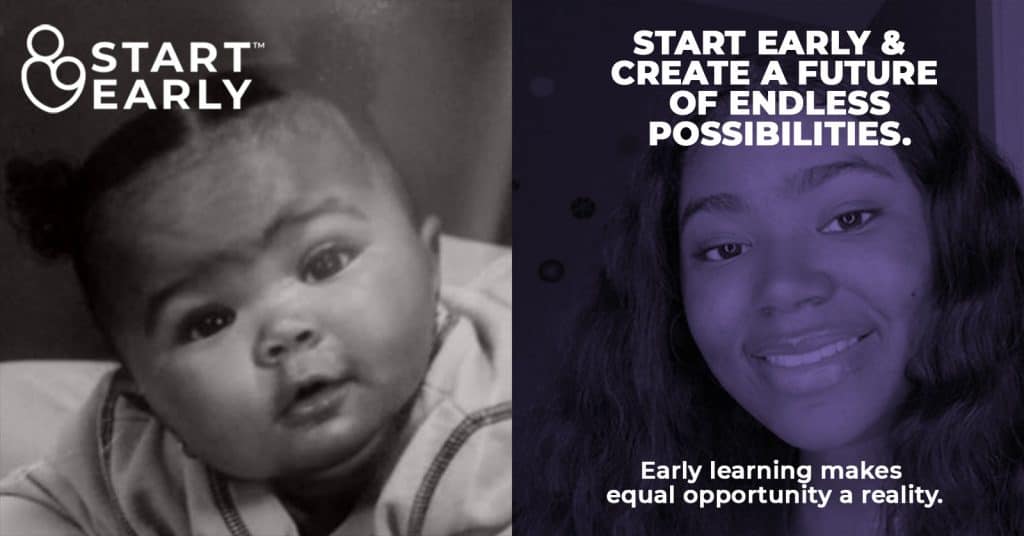In this blog post, Melissa Manning, with contributions from Sarah Bergman, share perspectives from the Educare Learning Network’s Early Head Start-Child Care Partnerships Community of Practice on rebuilding and recovery post COVID-19. Including, specific thoughts on equitable access to high-quality early care and learning and the need for viewing early childhood systems through a racial equity lens.
In mid-June, after early learning settings were initially impacted by the COVID-19 pandemic, 12 early learning practitioners from seven states gathered virtually for a Build It Back Better dialogue. The dialogue took place during a meeting of the Educare Learning Network’s Community of Practice for Early Head Start-Child Care Partnership grantees and included leaders of Educare schools and child care providers. Below is a summary of what these leaders in the early childhood field shared about their experience with rebuilding and recovery post-COVID-19:
1. What are some of the hopes, dreams and goals for children that were shared during your Build It Back Better dialogue?
A hope is to provide children with the same educational opportunities as children in more affluent communities, as well as resourcing teachers to support their implementation of best practices in service of children’s school readiness and their own personal growth. We hope that all children will have the opportunity to reach their full potential and want to be mindful of what is needed for staff, communities and families to ensure children have those opportunities. We hope that a young child’s family income, race and/or adverse experiences do not predict their later success. Finally, when we see our kids, especially our Black and Latino kids, we want to be able to give them a fair shake in a world we know is not set up for them currently. Kids in our community who came to our programs are no longer living because of street and police violence. There is hopefulness to see changes to systemic racism in our lifetime.
2. What are some of the worries or concerns for children that were shared? What is keeping people up at night?
Children of color are growing up in a society with a long history of structural, institutionalized racism. So many kids are not in quality programs right now as programs start to reopen in limited capacities. We worry about the domestic and child abuse that might be going unreported right now. We are also worried about the social and emotional development and relationship-based work at every level – including physical contact especially with younger children.
Everything we know about child development is seemingly unavailable during this pandemic. We are worried about what the child care landscape is really going to look like for families. There was a teacher who tested positive the night before school was scheduled to reopen. The Remind app was then used to notify parents of a delayed reopening date. There were 55 families who were scheduled to arrive. Four families did not get the information – one uncle even tried to drop off a little girl, who got so upset that school was not open that day. This incident was a reminder that these kids are at home with family members and wanting to come back. Our kids need these environments. In some cases, we are their stability – their constant.
3. According to participants, how did the supports for young children and families respond or fare? Who has been disproportionately impacted by the challenges?
A positive has been that there was some security built in for families through child care subsidies. There was no parent fee, and slots were saved. Another positive has been smaller group sizes. Adults have time to build relationships with each other and kids.
Some negatives? It is up to states to figure out where their money lands, and that really varies. Also, funding that came through in grant form was insufficient in many cases. Head Start and child care in Illinois are not on the same page, and many programs could not open as emergency care because of the loopholes and discrepancies in policies and procedures. The longer a program stays closed, the harder it is to reopen. The Black Lives Matter movement has had a significant impact on the Educare Seattle community. For equity and racial justice to be a part of what we do, we must understand how white privilege plays out in the child care setting.
4. With respect to concerns or challenges shared, what did participants say has or would help alleviate these issues or make things better?
It would be helpful if different sub-systems were firmly aligned and communicating clear expectations. The conversation should also be raised between public school leaders and local child care providers. Providers want to be responsive to school decisions in order to best serve the community. We are still concerned, though, about how do we partner with families to empower themselves as the most important teacher for their child, while also meeting the need for child care and education? Some families are not quite ready to return on-site, but also not quite comfortable being their child’s teacher.
We want to make sure we are supporting families’ mental health situations and ensuring families have access to services and affordable technology. In order to make things better, we need to be able to manage movement effectively in case someone tests positive for COVID-19. Tulsa Educare was operating 7 a.m. – 6 p.m., and to make it work, there were so many substitutes, interns and aides required. So many folks going in and out. They’ve adjusted, so that now, there are three teachers with children all day. It is so calm. That is a solution that children will really benefit from.
5. As we work together to rebuild the early childhood system, what questions should we all be asking to ensure that ALL young children and families thrive?
We need to ask ourselves: what is it we really want? We need to slow down and have dialogues about this. What is it we want our children to experience? What kind of citizens do we want them to become? What is the role of profit in our child care industry? How can we cultivate more respect for teachers, especially our birth-to-age 5 teachers? Who do we want to be taking over this world? What skills do they need? And of course, in each conversation, we need to ask ourselves, how are the children?
To learn more about how Early Head Start-Child Care Partnership grantees have faced the COVID-19 pandemic and what policy recommendations they have made, please read the Educare Learning Network’s blog series “A Path to High-Quality Child Care through Partnerships.”
Build It Back Better is a project of Start Early (formerly the Ounce) focused on identifying the critical questions that early childhood systems and services must ask as we rebuild after the COVID-19 pandemic. The writings that emerge from the initiative center the experiences and voices of those most directly and disproportionately affected by the pandemic’s impact on early care and learning. Join the conversation at the Early Child Connector’s Recovery and Rebuilding Hub.
Melissa Manning is the Early Childhood Services Training and Professional Development Coordinator at Sunbeam Family Services and Co-Chair of the Educare Learning Network’s Early Head Start-Child Care Partnerships Community of Practice. Melissa has been in the field of early childhood education for three decades in a variety of capacities including, Infant/Toddler teacher, Center Director, Health Services Manager, Program Operations Manager, Quality Assessor and her current role as Training & Professional Development Coordinator for Sunbeam Family Services’ Early Childhood department. Melissa has worked with Head Start programs since 2002 and has extensive knowledge about Head Start Program Performance Standards, nonprofit management and best practices in the field.
Sarah Bergman was the Leadership and Educational Equity Fellow at Start Early this past summer. Sarah has her Master’s in Early Childhood Education from Erikson Institute and is a Chicago Public Schools teacher. Sarah’s interests are focused on bringing developmentally appropriate teaching practices to all primary aged students and connecting the dots between policy decisions and everyday life in the classroom.





